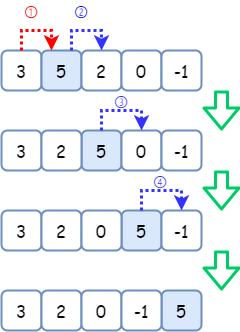- 学习参考B站郝斌老师的视频,文章内的源码如有需要可以私信联系。
结构体
- 为了表达一些复杂的事物,而普通的基本类型无法满足实际需求
- 把一些基本数据组合在一起,形成的一个新的复合数据类型,叫结构体
例:结构体举例
/*结构体*/
# include <stdio.h>
struct Student //定义结构体,由基本的变量构成
{
int age;
int score;
char sex;
};
int main(void)
{
struct Student st = {20, 85, 'M'}; //定义结构体变量
return 0;
}
例:定义结构体的方式
/*定义结构体*/
//第一种方式,推荐使用的方式
struct Student //只是定义了新的数据类型,并没有定义变量
{
int age;
int score;
char sex;
};
//第二种方式
struct Student
{
int age;
int score;
char sex;
}st;
//第三种方式
struct
{
int age;
int score;
char sex;
}st;
结构体变量的使用
- 赋值和初始化
- 定义的同时可以整体赋初始值
- 定义完后,只能单个的赋初始值
- 取出结构体变量中的每一个成员
结构体.成员名指针变量名->成员名
- 结构体变量的运算
- 结构体变量可以互相赋值,但是不能相加减,相乘除
例:结构体变量的赋值和初始化
/*结构体变量的赋值和初始化*/
# include <stdio.h>
struct Student
{
int age;
int score;
char sex;
};
int main(void)
{
struct Student st = {20, 85, 'M'}; //定义变量时赋值
struct Student st2; //定义完成后再赋值
st2.age = 20;
st2.score = 85;
st2.sex = 'M';
printf("%d %d %c
", st2.age, st2.score, st2.sex);
return 0;
}
/*运行结果*/
20 85 M
Press any key to continue
例:结构体中成员变量的取出
/*结构体中成员变量的取出*/
# include <stdio.h>
struct Student
{
int age;
int score;
char sex;
}; //分号不能省略
int main(void)
{
struct Student st = {20, 85, 'M'};
struct Student * pst = &st; //定义指针变量pst时存放结构体地址的
pst->age = 25; //在计算机内部会被转化为(*st).age
st.age = 25;
printf("%d %d %c
", st.age, pst->score, st.sex);
return 0;
}
pst->age等价于(*pst).age也等价于st.age
pst->age表示指针变量pst指向的结构体中的age这个成员变量
/*运行结果*/
25 85 M
Press any key to continue
例:通过函数完成对结构体变量的输入和输出
/*通过函数完成对结构体变量的输入和输出*/
# include <stdio.h>
# include <string.h> //使用strcpy需要定义头文件
struct Student
{
int age;
char sex;
char name[50];
};
void InputStudent(struct Student stu);
int main(void)
{
struct Student st;
InputStudent(st);
printf("%d %c %s
", st.age, st.sex, st.name);
return 0;
}
//此函数不能修改主函数中st的值
void InputStudent(struct Student stu)
{
stu.age = 10;
strcpy(stu.name, "Bad"); //对字符串的处理必须使用strcpy,不能直接使用stu.name='Bad'
stu.sex = 'M';
}
- 程序中,将变量st的值发送给stu,在定义的函数内,改变的是stu中的成员变量,当函数执行结束后,变量stu的存储空间被释放,不会修改主函数中st的值
- 即形参与实参的改变不互相影响
- 结构体中的成员变量都没有初始化,所以会使用垃圾数据填充,字符串知道读取到
�才会认为字符串读取完成
/*运行结果*/
-858993460 ?烫烫烫烫烫烫烫烫烫烫烫烫烫烫烫烫烫烫烫烫烫烫烫烫烫蘰
Press any key to continue
例:通过函数完成对结构体变量的输入和输出
/*通过函数完成对结构体变量的输入和输出*/
# include <stdio.h>
# include <string.h> //使用strcpy需要定义头文件
struct Student
{
int age;
char sex;
char name[50];
};
void InputStudent(struct Student *); //函数声明,需要指定形参的数据类型
void OutputStudent(struct Student);
int main(void)
{
struct Student st;
InputStudent(&st); //对结构体变量输入,将变量st的地址发送给函数
printf("%d %c %s
", st.age, st.sex, st.name);
OutputStudent(st); //对结构体变量输出,将变量st的值发送给函数
return 0;
}
void InputStudent(struct Student * pstu)
{
(*pstu).age = 20; //指针变量pstu用于存放st的地址,则*pstu即st的值
strcpy(pstu->name, "Bad");
pstu->sex = 'M';
}
void OutputStudent(struct Student stu)
{
printf("%d %c %s
", stu.age, stu.sex, stu.name);
}
- 定义结构体,即定义一个数据类型,其中包含多个基本变量
- 主函数中定义变量st,将st的地址发送到InputStudent函数,函数对结构体中的变量进行赋值
- 函数接收st的地址后,使用
(*pstu).age为结构体中的成员变量赋值- 指针变量
pstu存放的是st的地址,则*pstu存放的是st的值,所以(*pstu).age等价于st.age- 函数执行完后,主函数再将成员变量输出
OutputStudent函数因为只对结构体变量输出,不进行改变,所以在主函数中将变量st的值或地址发送给定义函数都可以
- 主函数发送的是地址会更好,因为如果直接发送内容,则需要发送的字节很多,而地址是固定的(4字节),可以减小内存的消耗,也可以提高执行速度
/*运行结果*/
20 M Bad
20 M Bad
Press any key to continue
冒泡排序
例:
/*冒泡排序*/
# include <stdio.h>
void Sort(int * a, int len)
{
int i, j, t;
for (i = 0; i < len - 1; ++i)
{
for (j = 0; j < len - 1 - i; ++j)
{
if (a[j] > a[j + 1])
{
t = a[j];
a[j] = a[j + 1];
a[j + 1] = t;
}
}
}
}
int main(void)
{
int a[5] = {3, 5, 2, 0, -1};
int i;
Sort(a, 5);
for (i = 0; i < 5; ++i)
printf("%d ", a[i]);
printf("
");
return 0;
}

- 主函数中定义一个数组
a[5],其中有五个元素,乱序存储,调用定义函数Sort,将数组的第一个元素存储的地址和数组的长度发送给Sort函数,对数组中的元素进行排序,然后对数组中的内容输出- 定义函数
Sort,形参接收主函数的数组中第一个元素存储的地址和数组长度- 冒泡排序:
- 将数组中的第一个数与第二个数进行比较,第二个数更大,则不需要交换位置
- 将数组中的第二个数与第三个数比较,第二个数更大,所以将第二个数放在第三个数的位置
- 依次类推,将最大的一个数放在数组最后的位置
- 再从剩下的
len - 1 - i个数中继续比较,将大的数放在剩下数中的最后一个位置- 排序后,最大的数或最小的数放在数组的最后,冒泡排序是将所有的数中两两之间进行比较,选出最大或最小的数
综合程序
- 要求用户输入需要录入的学生个数,然后依次录入学生的姓名、年龄、成绩,并根据成绩进行排序,排序后进行输出。
例:不使用函数
/*学生管理系统*/
# include <stdio.h>
# include <malloc.h>
/*定义结构体*/
struct Student
{
char name[50];
int age;
float score;
};
int main(void)
{
int len; //用于存放学生的个数
struct Student * p;
int i, j;
struct Student t; //用于交换学生名次的中间变量
/*动态构造一维数组*/
printf("请输入需要录入学生的个数:");
scanf("%d", &len); //将输入数值赋值给变量len
p = (struct Student *)malloc(len * sizeof(struct Student));
/*
动态构建一维数组
数组存放的数据类型为结构体定义的类型
动态分配的地址空间为学生个数 * 结构体所占的字节数
*/
/*输入学生信息*/
for (i = 0; i < len; ++i)
{
printf("请输入%d个学生的信息:
", i + 1);
printf("Nmae: ");
scanf("%s", p[i].name);
/*
name是数组名,本身即为第一个元素的地址,则不需要再取地址
%s表示从键盘接收的数据是char类型
p存放的是结构体的地址,结构体中有三个基本变量,所以需要使用p[i].name来指定赋值给哪个变量
*/
printf("Age: ");
scanf("%d", &p[i].age);
printf("Score:");
scanf("%f", &p[i].score); //%f表示从键盘接收的数据是float类型
}
/*对学生的成绩进行排序-冒泡排序*/
for (i = 0; i < len - 1; ++i)
{
for (j = 0; j < len - 1 - i; ++j)
{
if (p[j].score > p[j + 1].score) //大于号是升序,小于号是降序
{
t = p[j];
p[j] = p[j + 1];
p[j + 1] = t;
}
}
}
printf("
");
/*输出学生信息*/
for (i = 0; i < len; ++i)
{
printf("第%d名学生的信息如下:
", i + 1);
printf("Name: %s
", p[i].name);
printf("Age: %d
", p[i].age);
printf("Score: %f
", p[i].score);
printf("
");
}
return 0;
}
/*运行结果*/
请输入需要录入学生的个数:3
请输入1个学生的信息:
Nmae: Bad
Age: 20
Score:100
请输入2个学生的信息:
Nmae: Boy
Age: 18
Score:75
请输入3个学生的信息:
Nmae: Five
Age: 15
Score:85
第1名学生的信息如下:
Name: Boy
Age: 18
Score: 75.000000
第2名学生的信息如下:
Name: Five
Age: 15
Score: 85.000000
第3名学生的信息如下:
Name: Bad
Age: 20
Score: 100.000000
Press any key to continue
例:将学生成绩的录入、排序、输出定义成函数
/*学生管理系统*/
# include <stdio.h>
# include <malloc.h>
/*定义结构体*/
struct Student
{
char name[50];
int age;
float score;
};
/*输入学生信息函数*/
void Input_Info(struct Student * p, int len)
{
int i;
for (i = 0; i < len; ++i)
{
printf("请输入%d个学生的信息:
", i + 1);
printf("Nmae: ");
scanf("%s", p[i].name);
/*
name是数组名,本身即为第一个元素的地址,则不需要再取地址
%s表示从键盘接收的数据是char类型
p存放的是结构体的地址,结构体中有三个基本变量,所以需要使用p[i].name来指定赋值给哪个变量
*/
printf("Age: ");
scanf("%d", &p[i].age);
printf("Score:");
scanf("%f", &p[i].score); //%f表示从键盘接收的数据是float类型
}
}
/*对学生的成绩进行排序-冒泡排序*/
void Sort_Score(struct Student * p, int len)
{
int i, j;
struct Student t; //定义结构体中间变量,用于交换位置
for (i = 0; i < len - 1; ++i)
{
for (j = 0; j < len - 1 - i; ++j)
{
if (p[j].score > p[j + 1].score) //大于号是升序,小于号是降序
{
t = p[j];
p[j] = p[j + 1];
p[j + 1] = t;
}
}
}
}
/*输出学生信息函数*/
void Output_Info(struct Student * p, int len)
{
int i;
printf("
--------------------------
");
for (i = 0; i < len; ++i)
{
printf("第%d名学生的信息如下:
", i + 1);
printf("Name: %s
", p[i].name);
printf("Age: %d
", p[i].age);
printf("Score: %f
", p[i].score);
printf("
");
}
}
int main(void)
{
int len; //用于存放学生的个数
struct Student * p;
/*动态构造一维数组*/
printf("请输入需要录入学生的个数:");
scanf("%d", &len); //将输入数值赋值给变量len
p = (struct Student *)malloc(len * sizeof(struct Student));
/*
动态构建一维数组
数组存放的数据类型为结构体定义的类型
动态分配的地址空间为学生个数 * 结构体所占的字节数
*/
/*调用输入学生信息函数*/
Input_Info(p, len);
/*对学生的成绩进行排序-冒泡排序*/
Sort_Score(p, len);
/*调用输出学生信息函数*/
Output_Info(p, len);
return 0;
}
/*运行结果*/
请输入需要录入学生的个数:3
请输入1个学生的信息:
Nmae: Bad
Age: 20
Score:78
请输入2个学生的信息:
Nmae: Boy
Age: 18
Score:85
请输入3个学生的信息:
Nmae: Five
Age: 15
Score:63
--------------------------
第1名学生的信息如下:
Name: Five
Age: 15
Score: 63.000000
第2名学生的信息如下:
Name: Bad
Age: 20
Score: 78.000000
第3名学生的信息如下:
Name: Boy
Age: 18
Score: 85.000000
Press any key to continue
以上内容均属原创,如有不详或错误,敬请指出。
本文链接: https://blog.csdn.net/qq_45668124/article/details/115406296
版权声明: 本博客所有文章除特别声明外,均采用
CC BY-NC-SA 4.0 许可协议。转载请联系作者注明出处并附带本文链接!